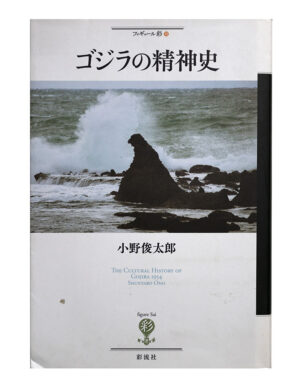9.27.2022
The Cultural History of Godzilla – Pt 11


P 28
こうした海底火山や台風という現象が現在も無縁でないのは、二〇一三年を考えただけでもわかる。十一月には小笠原諸島の西にある西之島の付近で海底爆発があり、新しい島が形成された。また十月の大型台風二十六号が記録的な大雨をもたらし、伊豆大島で土石流を発生させて大きな人的被害を与えた。その後の十一月の三十号はフィリピンのレイテ島やセブ島など日本と深い関わり合いをもつ島々を直撃し、死者一万人に及ぶ被害を与えた。こうした自然災害とゴジラの行動や被害とを結びつけることができる。
Just by thinking about 2013, we can see that the phenomenon of submarine volcanoes and typhoons is still relevant today. In November, an undersea explosion occurred near Nishinoshima, west of the Ogasawara Islands, forming a new island. In October, Typhoon No. 26 brought record-breaking rainfall, causing a mudslide on Izu-Oshima Island and inflicting great human damage. After that, in November, the 30th attack directly hit islands that had a deep relationship with Japan, such as Leyte Island and Cebu Island in the Philippines, and caused damage to the lives of 10,000 people. It is possible to connect these natural disasters with Godzilla’s actions and damage.
ジュラ紀の恐竜
Jurassic dinosaur
とはいえ、ゴジラは「死を免れることができない」生物である。自然災害だけでは片づけられない。海底火山の爆発や台風とおなじように自然物の一員だろうが、水爆実験のはるか以前から存在していぜん 恐竜と設定されている。ゴジラの正体は、予告編のナレーションが語る「二百万年前に棲息したジュラ紀の大怪獣ゴジラ」という説明につきる。本編でも古生物学者の山根博士がその点をくり返し強調している。
Godzilla, however, is a creature that cannot escape death. Natural disasters alone are not enough. They may be natural objects like submarine volcanic explosions and typhoons, but they existed long before the hydrogen bomb test and are still set as dinosaurs. The true identity of Godzilla is explained by the narration of the trailer as “Godzilla, a giant Jurassic monster that lived two million years ago.” In this volume, paleontologist Dr. Yamane repeatedly emphasizes this point.

P 29
映画の公開当時にマスコミが酷評したのは、ゴジラには「愛敬がない」とか「性格がない」ということだった。一九九八年に作られたBBCのドキュメンタリー番組に代表されるように、キングコングとゴジラの違いを霊長類と爬虫類に求めて、ゴジラとは意思の疎通ができないから不気味だとする意見もある。対象にどれだけ感情移入しやすいかどうかを評価の基準としているのだ。人間に姿かたちが近い大猿のキングコングならば、人間らしい葛藤をもっていると判定しやすい。 霊長類は爬虫類よりも進化した生物に思えるので納得してしまう。
At the time of the release of the movie, the mass media criticized Godzilla for being “no love” and “no personality.” As typified by the BBC documentary program made in 1998, there is an opinion that the difference between King Kong and Godzilla is sought in primates and reptiles, and that it is eerie because Godzilla cannot communicate with them. The criteria for evaluation is how easy it is to empathize with the target. King Kong, a great ape that resembles humans in appearance, is easy to judge as having human-like conflicts. Primates seem to be more evolved creatures than reptiles, so I’m convinced.
けれども、本多監督はゴジラを動物(つまり人間に近くないもの)だとみなして安易な擬人化を拒否していた。ゴジラが襲っている状況に右往左往する群衆を整理している兵士に、山根博士がゴジラの目に投光器の光を当てるなと指揮官に伝えてくれという忠告も、爬虫類の性質をとらえたものだった。テレビ塔からのカメラのフラッシュの光がゴジラを怒らせ、テレビ塔が倒されるのも、生物としてのゴジラを示すねらいがある。確かにモスラの場合のようにテレパシーでも使わない限り、人間が怪獣と会話をするのは不可能だ。コミュニケーションをとるのが不可能な点や人間的な感情の不在こそが、初代のゴジラの大きな特徴となっている。
However, director Honda regarded Godzilla as an animal (that is, something not close to humans) and refused to easily anthropomorphize it. Dr. Yamane’s advice to the soldiers who are directing the crowd that is rushing to and fro as Godzilla is attacking, to tell the commander not to shine the light from the floodlight on Godzilla’s eyes, also captures the nature of reptiles. The light of the camera flash from the TV tower makes Godzilla angry, and the TV tower is knocked down with the aim of showing Godzilla as a living creature. Certainly, it is impossible for a human to converse with a monster, unless telepathy is used, as in the case of Mothra. The impossibility of communication and the absence of human emotions are the major characteristics of the original Godzilla.
山根博士が口にした「ジュラ紀」は二百万年前ではなくて、実際には二億年ほど前の時期なので、この映画がもつ時代錯誤の例とみなされてきた。国会でのプレゼンテーションで、大きな地層図がスライドで映される。そこには白亜紀、儒羅紀、石炭紀と名称までつけられ、地層の関係をしめしていた。「二百万年前のジュラ紀」という設定は、香山滋による最初の「G作品検討用台本」から存在していた。フィクションといえども『ゴジラ』を支える科学的な考証や知識があやふやに思えて「でたらめや非科学的なことを書いて、児童を毒する」とか「子供だまし」と批判する人たちもいた、と香山滋は回想している。五四年に『少年ケニヤ」が映画化された絵物語作者の山川惣治も、「少年王者』(一九四七年)のなかで、同時代らしいアフリカの空にプテラノドンを飛ばし、黒いプロキオサウルスらしい恐竜を登場させている。同じような趣向だろう。しかも、山川の弟子の阿部和助の挿絵で、香山が「ゴジラ』のノベライズ版を出したのが、おなじ「おもしろブック」だった。
The “Jurassic period” that Dr. Yamane mentions is actually about 200 million years ago, not two million years ago, so it has been seen as an example of the film’s anachronism. During a presentation at the Diet, a large stratum map is shown on a slide. There were even names such as the Cretaceous, Jurassic and Carboniferous periods, showing the relationships between strata. The setting of “Jurassic period two million years ago” existed from the first “G work review script” by Shigeru Kayama. Even though it is fiction, the scientific evidence and knowledge that supports “Godzilla” seemed vague, and some people criticized it as “poisoning children by writing nonsense and unscientific things” or “deceiving children.” Shigeru Kayama recalls. Picture story author Soji Yamakawa, whose “Shonen Kenya” was made into a movie in 1954, also flies a pteranodon into the sky of Africa in “Shonen Ouja” (1947). A chiosaurus-like dinosaur appears, and it’s probably the same idea. Moreover, Kayama’s novelized version of “Godzilla” with illustrations by Yamakawa’s disciple Wasuke Abe was the same “Omoshiro Book.”